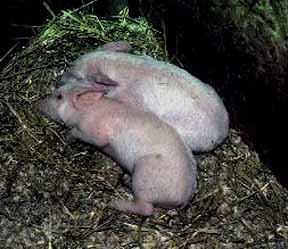



Streptococcal Meningitis
 Grower pig with Streptococcal meningitis  Piglets with Streptococcal meningitis |
Clinical signs
These are rapid in onset, the piglet lying on its belly and shivering. When presented with such symptoms also consider scour or joint infections from a septicaemia.
Meningitis is characterised by a continual movement of the eyes from one side to the other (nystagmus) and this is an early diagnostic symptom together with shivering and shaking, paddling and convulsions. In acute cases the piglet may just be found dead. Streptococcal meningitis may be worse in sucking pigs when the organism has been introduced into the herd for the first time, or where it is secondary to infection with PRRS.
Diagnosis
The organism must be isolated from the meninges of clinically affected pigs and identified in a laboratory.
Treatment
- If your herd has a problem always examine the at risk pigs twice daily to identify and treat affected pigs early.
- Streptococcus suis is usually sensitive to penicillin, synthetic penicillin's or sulphonamides.
- Injections of penicillin should be given twice daily.
- Good nursing is equally important because the condition is very painful. Remove the piglet during the first 3 to 6 hours from the litter to a warm environment and carefully supplement it with milk via a stomach tube.
Consider joint infections, glässers disease, generalised septicaemia, salt poisoning, aujeszky's disease and hypoglycaemia.
Management control and prevention
- It is possible to vaccinate the sow using an autogenous vaccine to improve the colostral immunity.
- The sow can be injected with long-acting penicillin just before farrowing.
- The litter can be injected with long-acting penicillin in anticipation of disease.







